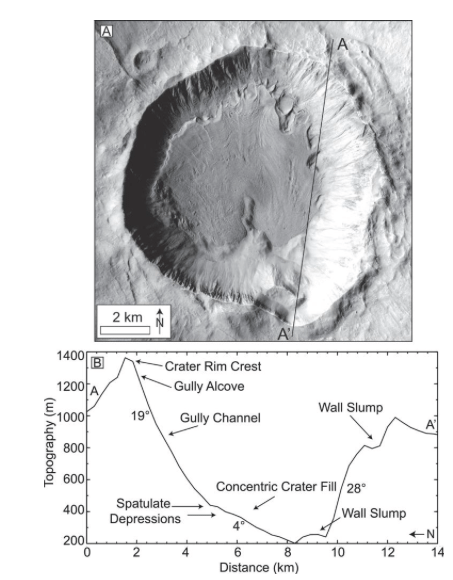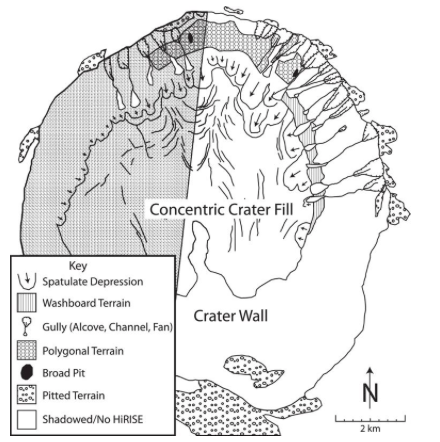
Most of the surface of Mars is currently too cold, and the atmosphere is too thin, for liquid water to be present on the surface. Even solid water ice is unstable and will sublimate (turn directly from ice into water vapor) if it is exposed on the surface of Mars because of the extremely thin atmosphere.
However, within the last few hundred million years – relatively recently on “geologic” time scales – ice was not just stable on the surface: it probably covered much of the regions between the poles and the equator (~30-60° latitude in both hemispheres), forming extensive glacial deposits that are still visible today.
Why were glaciers so common in the past, when ice is unstable at the surface now? It is believed that the climate of Mars has changed dramatically throughout its history due mainly to variations in the planet’s obliquity (the tilt of the planet’s rotational axis as it orbits the sun). By increasing the obliquity of a planet, the polar regions receive more direct sunlight, which causes water ice located in the polar caps to sublimate and travel to lower latitudes.
Therefore, in the past when Mars had a higher obliquity, ice would have accumulated and formed glaciers in the mid-latitudes. As an ice deposit grows thicker it will eventually begin to flow under its own weight, which is how glaciers form and move. Martian glacial features are extremely abundant in the mid-latitudes and are observed to flow off of isolated plateaus, through valleys, and even fill the interiors of craters (glacial features inside craters are called concentric crater fill, or CCF).

(A) The unnamed glaciated crater analyzed by the authors. Image from the Context Camera (CTX) onboard the Mars Reconnaissance Orbiter spacecraft. (B) Topographic profile of track A-A’, with prominent features and slopes noted, 10X vertical exaggeration. Topography data from the Mars Orbiter Laser Altimeter onboard the Mars Global Surveyor (MGS) spacecraft. Figure 5, from Jawin et al., 2018. Republished with permission from Elsevier from: https://doi.org/10.1016/j.icarus.2018.01.026
However, the obliquity of Mars is currently fairly low, and Mars is not in a period of glaciation at present. So what happened to these extensive glaciers? When the obliquity of Mars changed from a high value (~35° tilt of the rotational axis) when glaciers formed, to its current lower value (~25°), ice in the mid-latitudes would have sublimated rapidly and returned to the polar regions. The glacial features we observe today on Mars are merely the remnants of what were formerly much more extensive ice deposits that have been “sequestered” by a protective layer of sediment and rock to prevent further sublimation.
Recent work by researchers from Brown University (Jawin, Head, and Marchant) studied this transition between periods of extensive glaciation and the current ice-free period. As ice from a glacier was removed and returned to the poles, the deglaciation (or removal of ice) caused a period of rapid erosion and environmental change. This “paraglacial” period caused rapid erosion that created a group of geologic features (referred to as paraglacial features, since they formed during and after deglaciated occurred). The authors identified and analyzed a set of paraglacial features within a glaciated crater on Mars and argued they indicated a region was recently deglaciated.
By studying the appearance and relative age of these martian paraglacial features, the authors described the transition between the glacial period and the current period: ice was probably removed quickly, which caused large depressions to form near the base of crater walls. These depressions, called spatulate depressions, caused ice and sediment on the crater walls to become unstable, leading to the formation of other features such as washboard terrain, gullies, and polygons. The authors also used simulations the planet’s obliquity to determine that the paraglacial period on Mars probably began around 5 million years ago, and may still be ongoing.

Outlines showing the distribution of paraglacial features in the glaciated crater discussed in this work. Figure 6, from Jawin et al., 2018. Republished with permission from Elsevier from: https://doi.org/10.1016/j.icarus.2018.01.026
Based on this model of glacial-paraglacial transitions on Mars, the authors argue that in the future (when the obliquity increases and causes a new glacial period in the mid-latitudes) ice will flow into the crater again and fill up the spatulate depressions. A small ridge from the spatulate depressions will be all that is left to indicate the current paraglacial period occurred. They also suggest that older ridges in the glacial deposit (the CCF) are evidence of past glacial/paraglacial cycles. Similar patterns of glacier ridges have been found in glaciers in Antarctica that may be linked to climate cycles on Earth.
These results are important because they provide a method to study the number and characteristics of climate cycles on Mars within the last few hundred million years. The authors are currently documenting evidence of paraglacial features in all craters on Mars to determine how global climate cycles may have varied in different locations on the planet.
In addition, several martian paraglacial features may indicate where ice is currently trapped in the near-surface. These features could be useful when considering future human exploration locations on Mars because water ice is an extremely valuable resource in the local environment that can be extracted and utilized.
These findings are described in the article entitled Transient post-glacial processes on Mars: Geomorphologic evidence for a paraglacial period, recently published in the journal Icarus. This work was conducted by Erica R. Jawin and James W. Head from Brown University and David R. Marchant from Boston University.









